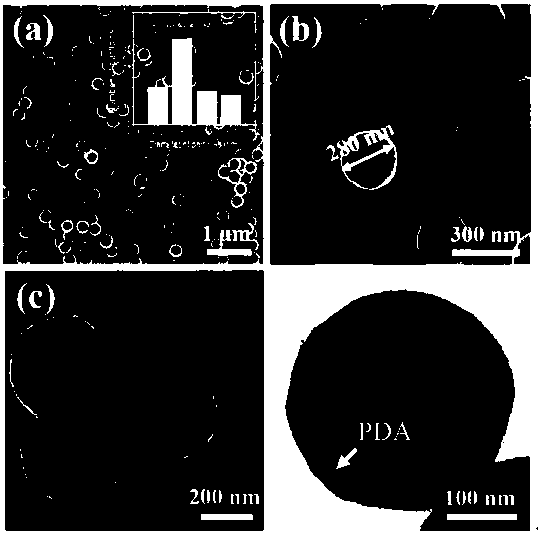Preparation method of yolk-shell structure molybdenum disulfide@ carbon electrode material
A molybdenum disulfide and carbon electrode technology, applied in battery electrodes, secondary batteries, structural parts, etc., can solve the problems of difficult to control the size of voids, loss of electrode volume energy density/power density, and particle density reduction, etc. Uniform size, outstanding rate performance, and small particle size
- Summary
- Abstract
- Description
- Claims
- Application Information
AI Technical Summary
Problems solved by technology
Method used
Image
Examples
Embodiment 1
[0020] 1) Add 12 mmol of elemental sulfur and 5 mmol of molybdenum trioxide to 300 ml of ethylene glycol solution, and sonicate in a water bath for 10 minutes to form a homogeneous solution. Then transfer the above solution to a 500 ml polytetrafluoroethylene autoclave and put it in an oven at a temperature of 200°C for 12 hours to obtain molybdenum disulfide nanospheres.
[0021] 2) Disperse 800 mg of the above-mentioned molybdenum disulfide nanospheres in 200 ml of Tris buffer (10 mM, pH = 8.5), add 200 mg of dopamine and stir slowly for 12 h to obtain molybdenum disulfide@polydopamine. Put molybdenum disulfide@polydopamine into a tube furnace at a heating rate of 5 ℃ / min and a protective gas of N 2 、Carbonized at 800℃ for 2 h to obtain core-shell structure molybdenum disulfide@carbon (named MoS 2 @C-0%,).
[0022] 3) Prepare a hydrogen peroxide solution with a concentration of 0.2 vol %, and then add 200 mg of the core-shell structure molybdenum disulfide@carbon, and stir vigoro...
Embodiment 2
[0025] 1) Add 12 mmol of elemental sulfur and 5 mmol of molybdenum trioxide to 300 ml of ethylene glycol solution, and sonicate in a water bath for 10 minutes to form a homogeneous solution. Then transfer the above solution to a 500 ml polytetrafluoroethylene autoclave and put it in an oven at a temperature of 200°C for 12 hours to obtain molybdenum disulfide nanospheres.
[0026] 2) Disperse 800 mg of the above-mentioned molybdenum disulfide nanospheres in 200 ml of Tris buffer (10 mM, pH = 8.5), add 200 mg of dopamine and stir slowly for 12 h to obtain molybdenum disulfide@polydopamine. Put molybdenum disulfide@polydopamine into a tube furnace at a heating rate of 5 ℃ / min and a protective gas of N 2 、Carbonized at 800℃ for 2 h to obtain core-shell structure molybdenum disulfide@carbon (named MoS 2 @C-0%,).
[0027] 3) Prepare a hydrogen peroxide solution with a concentration of 0.4 vol %, and then add 200 mg of the above core-shell structure molybdenum disulfide@carbon and stir v...
Embodiment 3
[0030] 1) Add 12 mmol of elemental sulfur and 5 mmol of molybdenum trioxide to 300 ml of ethylene glycol solution, and sonicate in a water bath for 10 minutes to form a homogeneous solution. Then transfer the above solution to a 500 ml polytetrafluoroethylene autoclave and put it in an oven at a temperature of 200 ℃ for 12 h to obtain molybdenum disulfide nanospheres.
[0031] 2) Disperse 800 mg of the above-mentioned molybdenum disulfide nanospheres in 200 ml of Tris buffer (10 mM, pH = 8.5), add 200 mg of dopamine and stir slowly for 12 h to obtain molybdenum disulfide@polydopamine. Put molybdenum disulfide@polydopamine into a tube furnace at a heating rate of 5 ℃ / min and a protective gas of N 2 、Carbonized at 800℃ for 2 h to obtain core-shell structure molybdenum disulfide@carbon (named MoS 2 @C-0%,).
[0032] 3) Prepare a hydrogen peroxide solution with a concentration of 0.6 vol %, then add 200 mg of the above core-shell structure molybdenum disulfide@carbon, and stir vigorous...
PUM
| Property | Measurement | Unit |
|---|---|---|
| diameter | aaaaa | aaaaa |
Abstract
Description
Claims
Application Information
 Login to View More
Login to View More - R&D
- Intellectual Property
- Life Sciences
- Materials
- Tech Scout
- Unparalleled Data Quality
- Higher Quality Content
- 60% Fewer Hallucinations
Browse by: Latest US Patents, China's latest patents, Technical Efficacy Thesaurus, Application Domain, Technology Topic, Popular Technical Reports.
© 2025 PatSnap. All rights reserved.Legal|Privacy policy|Modern Slavery Act Transparency Statement|Sitemap|About US| Contact US: help@patsnap.com



